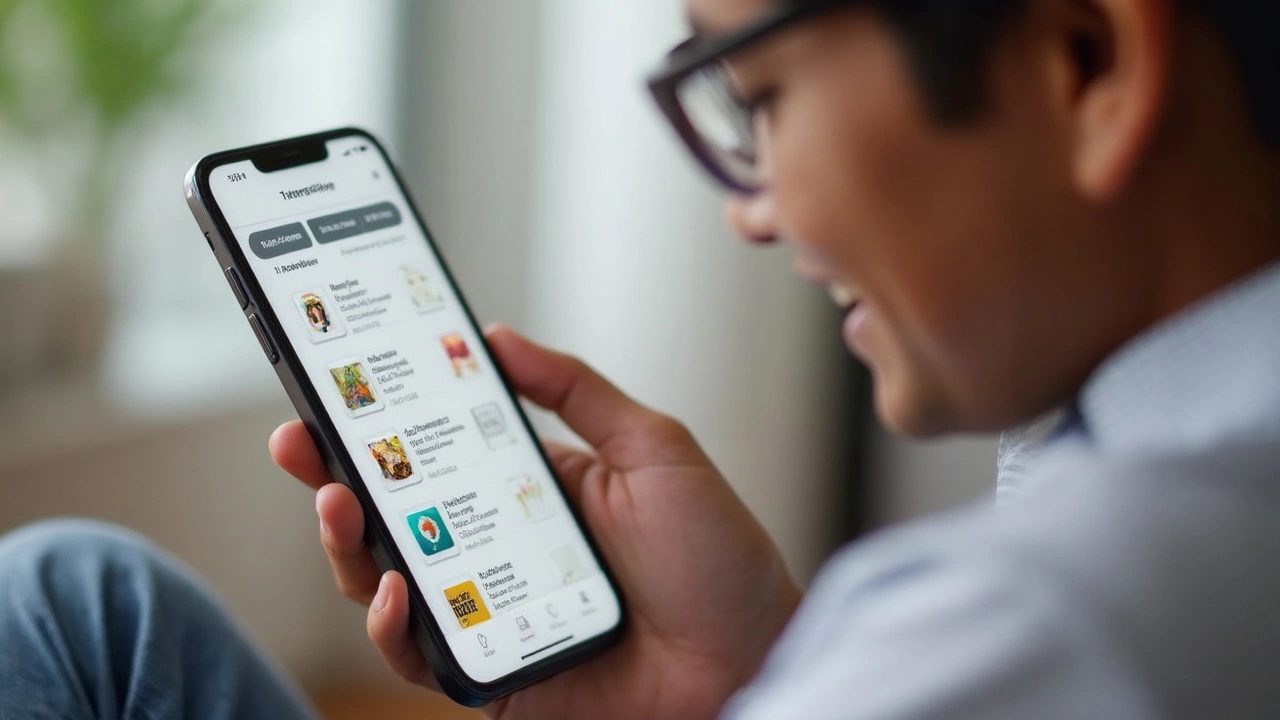Ever downloaded an educational app that promised to be free, only to hit a paywall right when things got interesting? You're not alone. It’s tough to tell which apps are actually free and which ones just bait you in. If you’re tired of 'free trials' and sneaky in-app purchases, you need to know which educational apps give you full access with zero fees.
The truth is, a lot of big-name study apps boast about being free, but lock half the content unless you pay up. Thankfully, there are still some solid apps out there that let you watch lessons, take quizzes, and even track progress without asking for your card. Whether you want to prep for exams, learn a language, or brush up on math, there’s real value to be found if you know where to look.
- What Does 'Totally Free' Really Mean?
- Real Free Apps—Not Just Free Trials
- Top 5 Educational Apps That Cost Nothing
- Tips for Getting the Most from Free Learning Platforms
- Hidden Pitfalls: Watch Out for These Tricks
- How to Choose the Best Free App for Your Needs
What Does 'Totally Free' Really Mean?
When an educational app says it's fully free, it means you get everything the platform offers without ever pulling out your wallet—no payment setup, no limited-time access, and no forced upgrades. A free educational app isn’t just one that lets you sign up without paying, but also lets you use all its learning tools, videos, lessons, and quizzes without hidden catches.
Here’s the tricky part: a lot of apps use words like “free” and “open” but still make most of their good stuff only available if you pay. For example, in 2024, an EdTech market report showed that about 67% of e-learning platforms labeled as "free" actually hid their main content behind paywalls or subscriptions. The table below breaks down the typical features you get with truly free versus "freemium" (free with paid extras) apps:
| Feature | Truly Free Apps | Freemium Apps |
|---|---|---|
| Full Access to Courses | Yes | Limited / Pay for full |
| No Ads | Sometimes | Usually not |
| Certificates | Rarely | Pay for certificate |
| Offline Download | Sometimes | Usually paid |
| Quizzes/Practice | Yes | Partial / Pay for all |
If you’re browsing for a free app, keep an eye out for these signs:
- No “upgrade to premium” pop-ups or reminders.
- Access to the entire library of courses and resources, not just samples.
- You can finish an entire course from start to finish, including assessments, without paying.
Don’t let slick marketing fool you. Just because an app is listed in the “free” section of your app store doesn’t mean you won’t have to pay down the line. Check user reviews and app descriptions for phrases like "in-app purchases" or "premium version required." If there’s even a mention, chances are you’ll eventually be asked to pay.
Real Free Apps—Not Just Free Trials
If you’ve been frustrated by apps that push upgrades after a few lessons, it’s time to look at platforms that actually stick to their word. A free educational app isn’t a trick—these options let you access all their core content with no strings attached.
Apps like Khan Academy, Coursera’s Audit mode, and Duolingo come up again and again for one simple reason: they’re totally up-front about what’s free and what isn’t. Here’s a quick rundown of what you really get with these apps:
- Khan Academy: 100% free for all ages, all subjects. You can take math lessons, prep for the SAT, or watch science videos without paying a dime or seeing any ads.
- Coursera (Audit Option): You won’t get a certificate, but if you just want to learn, you can access university-level courses in almost any subject for free. Watch all the videos and read the resources, no trial countdown ticking.
- Duolingo: The basic version covers dozens of languages and is ad-supported but doesn't force you to upgrade. Keep learning for as long as you want—no end date, no sudden paywall.
- BBC Bitesize: A goldmine for students in the UK, but it’s also useful for anyone looking for clear lessons and review guides. No fees anywhere—and no prompts to sign up with a credit card.
- CK-12: Focused on STEM, CK-12 offers digital textbooks, interactive lessons, and quizzes—all for free. Used by teachers and students worldwide, and there’s no limit to how much you can access.
If you want to know how these platforms stack up, check out this quick table below. It shows the truth behind what you get, so you can pick the right fit for your needs:
| App | Registration Required? | Ads/Pop-ups? | All Content Free? |
|---|---|---|---|
| Khan Academy | Optional | No | Yes |
| Coursera (Audit) | Yes | No | Yes (no certificate) |
| Duolingo | Yes | Yes (small and skip-able) | Yes |
| BBC Bitesize | No | No | Yes |
| CK-12 | No | No | Yes |
If you see an app asking for a payment method ‘just in case’ or promising ‘limited free access,’ that’s not truly free. Stick to these legit options to boost your knowledge without ever worrying about surprise fees.
Top 5 Educational Apps That Cost Nothing
Finding a free educational app that truly stays free isn’t as easy as it sounds. Some apps stop you with paywalls after a week; others just tease you with a few lessons unless you subscribe. Here are five apps you can trust to give you real value without pulling a money move later on.
- Khan Academy – Probably the most recognized free learning platform. It covers everything from grade school math to high school science, and even SAT prep. Their lessons are bite-sized, and you never get blasted with upgrade ads. Khan Academy has helped over 120 million users worldwide, making it a reliable go-to for students everywhere.
- Duolingo – If picking up a new language is your thing, Duolingo keeps all its main courses totally free. There are ads, but you can study Spanish, French, Japanese, and many more without ever paying. Over 50 million people use Duolingo each month to keep their daily streaks alive.
- Coursera (Audit Mode) – This one surprises a lot of folks! You can audit most Coursera courses for free, which means you get full access to lectures and resources, minus graded assignments or a certificate. It’s ideal for self-driven learners who just want the knowledge.
- OpenStax – Textbook prices can be brutal, but OpenStax offers legit, peer-reviewed digital textbooks for subjects like biology, physics, psychology, and more—all at no cost. Their books are used by millions of college students and even integrated into courses by thousands of schools.
- edX (Audit Track) – Like Coursera, edX lets you enroll in the "audit track" for most classes from top universities. You can watch all the video lessons, read the materials, and join in discussions for free. You only pay if you want a verified certificate.
Here’s a quick look at what you actually get with these apps, compared side by side:
| App | Main Subjects | Free Access Features | User Base |
|---|---|---|---|
| Khan Academy | Math, Science, History, SAT Prep | All lessons, quizzes, progress tracking | 120 million worldwide |
| Duolingo | Languages (40+) | All language courses and practice | 50 million monthly |
| Coursera (Audit) | University courses (variety) | Lectures, readings (no certificate) | Over 100 million registered |
| OpenStax | Core Subjects (college level) | Full digital textbooks | Millions of students |
| edX (Audit) | University courses | Videos, readings, forums (no certificate) | Over 45 million learners |
When you’re picking between these apps, think about what you actually need. Need structured lessons and quizzes? Try Khan Academy. Want to learn a new language with zero pressure? Go for Duolingo. If you’re curious about actual university courses but don’t care about a formal certificate, Coursera and edX have you covered. And if you’re tired of paying for textbooks, OpenStax is your best friend. All these options put free learning first, so no ugly surprises down the road.

Tips for Getting the Most from Free Learning Platforms
Once you’ve found a truly free educational app, you want to squeeze every drop of value out of it. But are you sure you’re using all its features? Some free apps actually pack in surprising extras—if you know where to look.
The key to mastering free educational apps is setting up good habits and making the most of the tools on offer. For example, Khan Academy doesn’t just serve videos—it tracks your progress, ranks your skills, and sends reminders. On Duolingo, streaks and XP keep you motivated, so don’t ignore those pop-ups.
- Set daily learning goals: Even 20 minutes a day adds up fast. Many platforms, like Coursera and SoloLearn, let you customize your schedule.
- Use built-in reminders: Free apps often send push notifications or emails. Turn these on to help you stick to your plan.
- Mix up your resources: Don’t just watch videos. Jump into quizzes, flashcards, and interactive practice. For example, edX provides short quizzes right after lessons for instant feedback.
- Track your progress: Apps like Memrise and Khan Academy have dashboards, so you know exactly where you stand and what you should review next.
- Join the community: Lots of free platforms have active discussion forums. If you’re stuck, ask a question—chances are, someone’s got an answer.
Want to know how people use free apps for real? Here’s a quick snapshot from 2024 based on survey data from e-Learning Industry:
| App Name | Avg. Daily Users | Most Used Feature |
|---|---|---|
| Khan Academy | 18 million | Interactive exercises |
| Duolingo | 14 million | Language streaks |
| Coursera (free tier) | 6 million | Video lectures |
| edX (audit mode) | 3.2 million | Short quizzes |
Bottom line? Use all the tricks the platform offers, and keep mixing up your routine. Free doesn’t mean basic or boring—if you tap into the features, you’ll get big results without spending a dime.
Hidden Pitfalls: Watch Out for These Tricks
Not all "free" educational apps are what they seem. Here’s the tough truth: big promises often hide sneaky tactics. Knowing these tricks helps you spot real free educational apps from the ones just pretending to be.
Pay special attention to:
- Limited lessons: Some apps let you access basics for free, then block the rest unless you pay. If the app only lets you do five quizzes or view three videos before locking things up, that’s not truly free.
- "Freemium" features: Look out for must-have tools—like practice tests or progress tracking—that hide behind a paywall. Duolingo and Photomath, for example, offer a solid free version, but things like unlimited mistakes or detailed explanations are premium-only.
- Ads everywhere: Free apps are loaded with ads sometimes. Not only are ads annoying, but some free apps squeeze them in every few seconds. If you’re studying, that gets frustrating fast. Even worse, tapping the wrong spot by accident might send you out of the app or on to a site you didn’t want.
- Personal data collection: Some "free" apps aren’t making money off you directly, but instead sell your data—like your email, study habits, or even location—to advertisers. Always check the app’s privacy policy before signing up.
- Sudden paywalls: A classic trick: you finish a big chunk of lessons only to get asked for payment right before a test or certificate. If reviews say the app "started charging out of nowhere," that’s a red flag.
Quick tip: Always scan user reviews before downloading. People are quick to call out apps that aren’t honestly free. And check the permissions before you sign up—no real educational app should need access to your contacts or photos.
How to Choose the Best Free App for Your Needs
Scrolling through the app store is overwhelming—there's a sea of so-called “totally free” learning apps, but not all of them will actually help you learn. So how do you find the one that fits? First, pin down your goal. Want to ace a school subject, learn a language, or just boost your skills for fun? Each free app tends to focus on its own thing, and some are much stronger in certain areas.
Apps like Khan Academy have no hidden fees and cover tons of subjects from elementary school to college level. If you want a “no surprises” experience, this one’s a safe bet. For language learning, Duolingo gives full access to its lessons without forcing you to pay (just be ready for a few ads). If interactive science projects are your thing, try PhET Simulations from the University of Colorado—they're free and well-respected by teachers everywhere.
"If you want to make the most of online education, focus on platforms with expert content, not just flashy design." — Common Sense Education
Here’s how to make a smart choice:
- free educational apps should be honest about costs—check the app store description for “in-app purchases” or “offers subscriptions.” If you spot those terms, expect limits.
- Look at the app’s reviews. If people complain about sudden paywalls, it’s a red flag.
- See if the app matches your learning style. Prefer watching videos, reading notes, or doing quizzes? Some apps lean heavy on one format.
- Are you studying elementary math, prepping for SATs, or learning Spanish for travel? Filter apps based on your real goal, not just popularity.
- Check if your progress gets saved or synced. Some free apps reset your progress unless you register for a paid account.
One more tip—if the app comes from a well-known nonprofit or university, you’re less likely to run into sneaky upsells. Double-check for regular updates too, because outdated apps can be buggy or just plain wrong.



